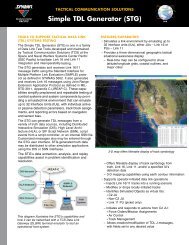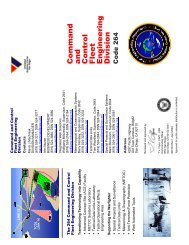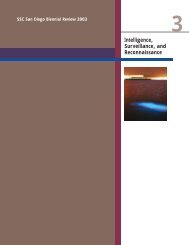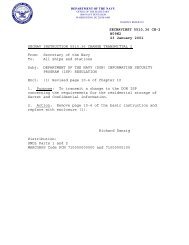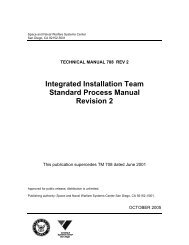Systems Integration Facility: Past, Present, and Future - Spawar
Systems Integration Facility: Past, Present, and Future - Spawar
Systems Integration Facility: Past, Present, and Future - Spawar
Create successful ePaper yourself
Turn your PDF publications into a flip-book with our unique Google optimized e-Paper software.
<strong>Systems</strong> <strong>Integration</strong> <strong>Facility</strong>:<br />
<strong>Past</strong>, <strong>Present</strong>, <strong>and</strong> <strong>Future</strong><br />
David P. Andersen<br />
SSC San Diego<br />
Karen D. Thomas<br />
Digital Wizards, Inc.<br />
The <strong>Systems</strong> <strong>Integration</strong> <strong>Facility</strong> (SIF) opened in 1990 in Building 600<br />
at SSC San Diego to support the Navy's first Joint Tactical Information<br />
Distribution System (JTIDS) developmental test program. Developed<br />
out of a need for a controlled, repeatable test environment to verify JTIDS<br />
terminal performance <strong>and</strong> combat systems interoperability, the SIF has<br />
become the Navy's leading laboratory for tactical data link interoperability<br />
testing.<br />
Sharing near-real-time tactical data in a distributed, interoperable, <strong>and</strong><br />
secure environment is a critical segment of warfighter universal information<br />
access. Tactical data links, specifically Link-11 <strong>and</strong> Link-16, now the<br />
Department of Defense's primary data link, <strong>and</strong> the future Link-22, provide<br />
this capability to Navy, Joint, <strong>and</strong> Allied forces.<br />
SSC San Diego has been involved with tactical data link development,<br />
test, evaluation, integration, <strong>and</strong> life-cycle support since the early 1960s.<br />
Under sponsorship of the Space <strong>and</strong> Naval Warfare <strong>Systems</strong> Comm<strong>and</strong>'s<br />
Advanced Tactical Data Links Program Office (PMW 159), the SIF has<br />
played an integral role as the central node of a complex stimulation/<br />
simulation environment for l<strong>and</strong>-based testing <strong>and</strong> evaluation of Link-16<br />
components <strong>and</strong> systems <strong>and</strong> integration with other data link systems.<br />
SIF operations are part of SSC San Diego D45, the Tactical <strong>Systems</strong><br />
<strong>Integration</strong> <strong>and</strong> Interoperability Division.<br />
The first- <strong>and</strong> second-generation Link-16 uses the JTIDS data terminal,<br />
which provides multiple-access, high-capacity, jam-resistant digital data<br />
<strong>and</strong> secure voice communication, navigation, <strong>and</strong> identification information<br />
to various comm<strong>and</strong> <strong>and</strong> control <strong>and</strong> weapons host platforms. The<br />
JTIDS terminals encompass software, radio frequency (RF) equipment,<br />
<strong>and</strong> the waveform they generate. Link-16 requires JTIDS terminals <strong>and</strong><br />
host combat systems such as the Advanced Combat Direction System<br />
(ACDS) or Aegis Comm<strong>and</strong> <strong>and</strong> Decision (C&D), processors such as the<br />
shipboard Comm<strong>and</strong> <strong>and</strong> Control Processor (C2P) or the F14-D Mission<br />
Computer, Link-16 antennas, other hardware, software, <strong>and</strong> displays. The<br />
C2P was developed at SSC San Diego to provide data forwarding <strong>and</strong><br />
translation between Link-16, Link-11, <strong>and</strong> Link-4A.<br />
Using Time Division Multiple Access communications architecture, Link-16<br />
terminals transmit information in the Tactical Digital Information Link-<br />
Joint (TADIL-J) message format. A common communications net is thus<br />
provided to a large community of airborne <strong>and</strong> surface elements within<br />
line of sight, <strong>and</strong> the network can be extended to platforms beyond line<br />
ABSTRACT<br />
This paper traces the development<br />
of SSC San Diegos <strong>Systems</strong><br />
<strong>Integration</strong> <strong>Facility</strong> (SIF) <strong>and</strong> the<br />
Combined Test Bed (CTB) that,<br />
together, provide a flexible, fully<br />
integrated multi-platform test<br />
capability used by dozens of multiservice<br />
<strong>and</strong> multinational testing<br />
organizations to ensure the interoperability<br />
of tactical data link<br />
systems. The paper describes<br />
unique PC-based Data Link Test<br />
Tools vital to Link-16 testing<br />
components. It also chronicles<br />
work of the major comm<strong>and</strong>,<br />
control, communications,<br />
computers, <strong>and</strong> intelligence<br />
(C4I) interoperability testing<br />
organizations, such as Naval Sea<br />
<strong>Systems</strong> Comm<strong>and</strong>s Distributed<br />
Engineering Plant (DEP), <strong>and</strong><br />
describes how the SIF/CTB will<br />
continue to support future<br />
tactical data link testing.<br />
155
156<br />
C 4 ISR SYSTEMS INTEGRATION AND INTEROPERABILITY<br />
of sight by using one or more<br />
members of the net, or any Link-<br />
16 terminal, as relays.<br />
When the Navy JTIDS developmental<br />
test program was established<br />
to verify the technical<br />
adequacy of the JTIDS terminal<br />
<strong>and</strong> the integration of Link-16<br />
into designated Navy host combat<br />
platforms, a l<strong>and</strong>-based laboratory<br />
environment for terminal<br />
specification testing <strong>and</strong> multiplatformintegration/interoperability<br />
testing was needed as a<br />
cost-effective precursor to live<br />
platform testing <strong>and</strong> to allow<br />
problem resolution.<br />
The SIF was designed to utilize a<br />
complex multi-computer simulator/<br />
stimulator connected to eight<br />
JTIDS terminals linked together<br />
by an RF network that introduced<br />
propagation delays <strong>and</strong><br />
attenuation into tactical message<br />
traffic. The test bed also included external communications equipment, an<br />
antenna, test scripting, data storage, reduction, <strong>and</strong> analysis equipment,<br />
<strong>and</strong> various interfaces.<br />
By September 1991, the SIF provided a fully integrated multi-platform<br />
functional testing capability. The SIF/Combined Test Bed (CTB) used<br />
intermediate processors to tie together the SIF <strong>and</strong> the Combat Direction<br />
System Development <strong>and</strong> Evaluation Site (CDES) laboratory in the same<br />
building, the E-2C Software Support Activity (SSA) laboratory in<br />
Building C-60, <strong>and</strong> the F-14D Mission Computer Subsystems Software<br />
Development Laboratory at Pt. Mugu, California. The CDES contains<br />
shipboard combat system configurations <strong>and</strong> programs for testing CV,<br />
LHD, Aegis CG/DDG, <strong>and</strong> LHA platforms. It also serves as the primary<br />
development <strong>and</strong> testing laboratory for the C2 FUTURA<br />
The early SIF. Many of the original components of the <strong>Systems</strong> <strong>Integration</strong> <strong>Facility</strong> shown<br />
in this 1992 photo have since been replaced by "New SIF" distributed components hosted<br />
on personal computers, enabling an infinite number of system configurations that can be<br />
tailored to support a large number of test <strong>and</strong> training scenarios.<br />
P. The E-2C laboratory<br />
consists of actual E-2C Airborne Tactical Data System (ATDS) software<br />
<strong>and</strong> hardware components. The F-14D facility consists of actual F-14D<br />
software <strong>and</strong> hardware components.<br />
By early 1993, the CTB was extended to the Aegis Combat <strong>Systems</strong><br />
Center, Wallops Isl<strong>and</strong>, Virginia, for testing <strong>and</strong> integrating Aegis combat<br />
systems. Later, to support developmental testing of the new generation of<br />
Link-16 terminals, the Multifunctional Information Distribution System<br />
(MIDS), the F/A-18 Advanced Weapons Laboratory at the Naval Air<br />
Warfare Center, China Lake, California, was added to the CTB.<br />
The SIF is the central node of the CTB, providing a central script controller<br />
to run the test information <strong>and</strong> direct it to real or simulated host<br />
systems that control the appropriate terminal type in the SIF terminal<br />
farm. The unique JTIDS RF simulation environment in the SIF provides<br />
connectivity between the SIF terminals, with digital propagation delays<br />
<strong>and</strong> attenuation matched to a scripted scenario. To support exercises that<br />
require live transmission rather than SIF RF network simulations, two
<strong>Systems</strong> <strong>Integration</strong> <strong>Facility</strong>: <strong>Past</strong>, <strong>Present</strong>, <strong>and</strong> <strong>Future</strong> 157<br />
JTIDS antennas were installed on<br />
the roof of Building 600. Mobile<br />
JTIDS vans <strong>and</strong> portable JTIDS<br />
units, called mini-racks, were<br />
developed by the SIF team for<br />
deployment in other test locations<br />
or for installation on surface vessels.<br />
As tests were conducted,<br />
other SIF systems enabled collection<br />
of the test data for later<br />
replay <strong>and</strong> analysis.<br />
The concept for JTIDS development<br />
<strong>and</strong> integration was to proceed<br />
through increasingly complex<br />
testing, from technical evaluation<br />
of the terminal to integration<br />
with the C2P, then with the<br />
ACDS, <strong>and</strong>, finally, with air programs.<br />
Following the initial terminal<br />
testing program in the<br />
early 1990s, the SIF/CTB <strong>and</strong><br />
D45 test <strong>and</strong> evaluation team<br />
members played major roles in<br />
the JTIDS <strong>and</strong> C2P technical<br />
evaluation (TECHEVAL) processes that paved the way to a major milestone<br />
in the Link-16 program––the successful completion in 1994 of the<br />
required operational evaluation (OPEVAL) of the JTIDS <strong>and</strong> C2P development<br />
program during the USS Carl Vinson (CVN 70) Battle Group's<br />
deployment to the Persian Gulf. This important step in the introduction<br />
of Link-16 <strong>and</strong> the C2P into the Fleet was the culmination of years of<br />
development work by Navy activities <strong>and</strong> supporting contractors. It was<br />
also the beginning of new challenges for the SIF/CTB.<br />
Early in the development of the SIF test bed, it was realized that significant<br />
modifications would be needed to support emerging test requirements.<br />
New capabilities were being added to Link-16 terminals. The new<br />
MIDS program was being planned, <strong>and</strong> the SIF would be the lead laboratory<br />
for terminal testing <strong>and</strong> integrating MIDS into Navy platforms,<br />
under sponsors PMW 159 <strong>and</strong> the MIDS International Program Office<br />
(PMW 101). The MIDS is a smaller, lighter weight terminal that maintains<br />
all JTIDS functionality. C4 FUTURA<br />
Shipboard combat system equipment in the Combat Direction System Development <strong>and</strong><br />
Evaluation Site (CDES) laboratory in 1992. The CDES is an integral part of the <strong>Systems</strong><br />
<strong>Integration</strong> <strong>Facility</strong>/Combined Test Bed for data link testing.<br />
I interoperability testing needed to<br />
exp<strong>and</strong> to support Joint service <strong>and</strong> multinational interoperability scenarios,<br />
<strong>and</strong> interoperability testing needed to support operations in multilink<br />
environments.<br />
While the SIF/CTB had provided valuable feedback to the Navy's JTIDS<br />
Program Office concerning the functional performance of Link-16 terminals<br />
<strong>and</strong> integration of the terminals with combat systems, its capability<br />
to support multi-service <strong>and</strong> multinational integration <strong>and</strong> interoperability<br />
testing was somewhat limited. A method of easily interfacing multi-service<br />
<strong>and</strong> multinational host combat systems was needed, as well as a system<br />
for addressing multi-link issues. These requirements led to the next<br />
developmental phase of the test bed.<br />
Cost/benefit studies conducted by systems engineers from SSC San Diego<br />
<strong>and</strong> supporting contractors concluded that while the equipment in the
158<br />
C 4 ISR SYSTEMS INTEGRATION AND INTEROPERABILITY<br />
SIF was capable, it was costly to maintain <strong>and</strong> difficult to modify. The<br />
long-range functional requirements for the SIF/CTB could best be met<br />
by a complete re-engineering of the test bed's systems.<br />
In the mid-1990s, development began on "New SIF" architecture. Its<br />
goal was to be a system with greater capability that could respond quickly<br />
<strong>and</strong> cost-effectively to the rapid evolution in functional requirements <strong>and</strong><br />
could provide cost-effective test <strong>and</strong> evaluation support to any tactical<br />
platform, regardless of location or terminal availability. The "New SIF"<br />
would use commercial-off-the-shelf IBM-compatible personal computers<br />
<strong>and</strong> the OS/2 operating system that accommodated the robust multitasking<br />
required by the systems <strong>and</strong> provided a friendly graphical user<br />
interface. "New SIF" systems would be based on common software<br />
architecture to allow rapid development <strong>and</strong> flexibility when requirements<br />
changed.<br />
By 1995, the Link-16 Gateway, now known as the Data Link Gateway<br />
(DLGW) system, was developed by D45 with contractor support to connect<br />
hosts at remote laboratories to the JTIDS <strong>and</strong> MIDS terminals in the<br />
SIF. The versatile PC-based Gateway system permitted the interfacing of<br />
multiple terminal farms, development laboratories, software support<br />
activities, live assets, <strong>and</strong> certification <strong>and</strong> simulation activities, forming a<br />
single extended Link-16 network for testing <strong>and</strong> integration. The Gateway<br />
system is composed of multiple DLGW units linked by secure dialup<br />
phone lines or higher speed communications systems. Each DLGW<br />
can function as a host emulator, as a terminal emulator, or as a network<br />
monitor. The Gateway software provides a suite of functions that allows<br />
users to participate in data link exercises, <strong>and</strong> monitor, control, record,<br />
<strong>and</strong> analyze data from the exercises.<br />
Other PC-based Data Link Test Tools were developed, including the<br />
following:<br />
· Script Controller for executing test scripts on the SIF script network.<br />
· Simulation Interface Units (SIUs) for translating scenario data in SIF<br />
format to the format <strong>and</strong> protocol needed by specific simulation systems.<br />
· TADIL-J Host Simulator, a scenario-driven or real-time tactical data<br />
system emulator that creates realistic participants for testing <strong>and</strong> training.<br />
· Link-16 Engine to support interconnection of non-Link-16-capable<br />
systems to the Gateway system.<br />
· Script Generator for creating test scripts that pass events to various<br />
Data Link Test Tools for processing on a Link-16 network.<br />
· Data Analysis <strong>and</strong> Reduction Tool (DART) for post-test analysis.<br />
The original SIF systems were replaced by the "New SIF" distributed<br />
components hosted on PCs <strong>and</strong> communicating through Transmission<br />
Control Protocol/Internet Protocol (TCP/IP) on an Ethernet local area<br />
network (LAN). Because the new systems were interconnected to operate<br />
as a single distributed system, the re-engineered test bed offered an<br />
infinite number of system configurations that could be tailored to support<br />
a large number of test <strong>and</strong> training scenarios.<br />
Each of the systems comprising the "New SIF" is a complex system in its<br />
own right, <strong>and</strong> each has evolved <strong>and</strong> continues to evolve to meet various<br />
new functional requirements. The SIF/CTB is a meta-system whose components<br />
are interconnected <strong>and</strong> mutually supporting. Within the SIF<br />
itself, systems communicate over the Script Net LAN. The remote sites<br />
are connected in a wide area network by the DLGW system, which
multiplexes Link-16 <strong>and</strong> scenario data between sites. At the remote sites,<br />
SIUs convert the scenario data into the form needed by the site-specific<br />
simulation system so that all systems are not only communicating in the<br />
same link environment, but also participating in a single coordinated<br />
scenario.<br />
By 1996, the "New SIF" began to evolve into a major hub for Joint <strong>and</strong><br />
multinational C4I interoperability testing <strong>and</strong> training, as well as a facility<br />
for testing new Link-16 terminal types such as the MIDS. Today, Data<br />
Link Test Tools provide Link-16 connectivity between the SIF <strong>and</strong> more<br />
than 100 Joint <strong>and</strong> international test <strong>and</strong> software support facilities, as<br />
well as all SSC San Diego C4I laboratories, including the Research,<br />
Evaluation <strong>and</strong> <strong>Systems</strong> Analysis (RESA), the Reconfigurable L<strong>and</strong>-<br />
Based Test Site (RLBTS), <strong>and</strong> the Global Comm<strong>and</strong> <strong>and</strong> Control System<br />
(GCCS). By installing a DLGW system at each of the remote facilities<br />
<strong>and</strong> linking them by telephone lines or high-speed circuits, a Gateway<br />
network is created. This connectivity enables a worldwide TADIL <strong>and</strong><br />
systems interoperability test capability.<br />
In addition to the unique combination of assets in the SIF/CTB, key to<br />
the success of the TADIL testing programs is one of the most experienced<br />
<strong>and</strong> knowledgeable Link-16 engineering <strong>and</strong> test <strong>and</strong> evaluation<br />
(T&E) teams in the world. The D45 T&E team has supported at-sea testing<br />
<strong>and</strong> engineering programs since the early 1990s. The team's extensive<br />
h<strong>and</strong>s-on engineering experience from early Navy JTIDS terminal testing<br />
to the complex interoperability test programs of today has provided a<br />
valuable resource for testing <strong>and</strong> integration programs.<br />
Today, a wide variety of JTIDS <strong>and</strong> MIDS testing activities are offered by<br />
the SIF/CTB, including terminal functionality <strong>and</strong> specification testing,<br />
pre-installation testing <strong>and</strong> checkout, relative navigation performance<br />
evaluation, JTIDS terminal network load testing, TDS-to-TDS interoperability<br />
testing, multi-TADIL/<br />
multi-platform interoperability<br />
testing, TADIL network performance<br />
evaluation, TADIL<br />
trouble report testing, TADIL<br />
st<strong>and</strong>ards certification testing,<br />
new TADIL "proof-of-concept"<br />
analysis, <strong>and</strong> live fleet service<br />
support. In addition, the test bed<br />
supports production testing of<br />
JTIDS terminal firmware upgrades<br />
for the Comm<strong>and</strong> <strong>and</strong> Control<br />
Fleet Engineering Division's<br />
JTIDS/MIDS SSA (SSC San<br />
Diego D64), <strong>and</strong> Product<br />
Acceptance Testing (PAT) <strong>and</strong><br />
Functional Interoperability<br />
Testing (FIT) for the C2P SSA.<br />
Scores of testing organizations<br />
have used the SIF/CTB resources.<br />
One of the first to use the<br />
DLGW systems <strong>and</strong> the "New<br />
SIF" for integration <strong>and</strong> interoperability<br />
was the Theater Missile<br />
<strong>Systems</strong> <strong>Integration</strong> <strong>Facility</strong>: <strong>Past</strong>, <strong>Present</strong>, <strong>and</strong> <strong>Future</strong> 159<br />
FUTURA<br />
The SIF today. PC-hosted Data Link Test Tools communicating via TCP/IP protocols on<br />
an Ethernet local area network have replaced the original systems in the SIF, which is now<br />
the Navy's leading laboratory for tactical data link interoperability testing.
160<br />
C 4 ISR SYSTEMS INTEGRATION AND INTEROPERABILITY<br />
Defense System Exerciser<br />
(TMDSE), a program of the<br />
Ballistic Missile Defense Organization<br />
(BMDO) to integrate the<br />
entire TMD family of systems<br />
<strong>and</strong> test interoperability issues<br />
between the various TMD systems.<br />
The SIF/CTB supports<br />
certification testing programs<br />
conducted by the Joint Interoperability<br />
Test (JIT) network<br />
directed by the Joint Interoperability<br />
Test Comm<strong>and</strong> (JITC)<br />
<strong>and</strong> by the Navy Center for<br />
Tactical <strong>Systems</strong> Interoperability<br />
(NCTSI). The SIF is the lead laboratory<br />
for the ongoing MIDS Low Volume Terminal (MIDS-LVT) <strong>and</strong><br />
MIDS on Ship (MOS) test <strong>and</strong> evaluation programs. The SIF/CTB <strong>and</strong><br />
the D45 T&E teams have played a significant role in the North Atlantic<br />
Treaty Organization (NATO) program to test the St<strong>and</strong>ard Interface<br />
for Multiple Platform Link Evaluation (SIMPLE), <strong>and</strong> the test bed has<br />
been used in many of the Navy's Comm<strong>and</strong>er, Operational Test <strong>and</strong><br />
Evaluation Force (COMOPTEVFOR) testing programs. The SIF has<br />
been accredited by COMOPTEVFOR for operational testing of the<br />
rehosted C2P <strong>and</strong> the MOS terminal.<br />
The SIF/CTB is a development <strong>and</strong> l<strong>and</strong>-based testing <strong>and</strong> evaluation<br />
environment for the C2P, the rehosted C2P, the Common Data Link<br />
Management System (CDLMS) <strong>and</strong>, most recently, for the Multi-TADIL<br />
Capability (MTC) Global Comm<strong>and</strong> <strong>and</strong> Control System–Maritime<br />
(GCCS–M) program. The MTC will provide a st<strong>and</strong>ard <strong>and</strong> interoperable<br />
data link capability for exchanging information on TADIL-A, TADIL-B,<br />
TADIL-J, <strong>and</strong> Satellite TADIL-J (S-TADIL-J) across the entire Joint<br />
environment. The SIF has been equipped with computer systems dedicated<br />
to the MTC program, currently developed for use with GCCS–M. To<br />
support interoperability <strong>and</strong> integration testing of Aegis ship classes <strong>and</strong><br />
related subsystems, the Integrated Combat System Test <strong>Facility</strong> (ICSTF),<br />
a field activity of Naval Sea <strong>Systems</strong> Comm<strong>and</strong> (NAVSEA) located at<br />
SSC San Diego, has located its Aegis 5.3.7 test bed in the CDES.<br />
The SIF/CTB has supported the Cooperative Engagement Capability<br />
(CEC) "Road to OPEVAL" integrated testing program since 1996. The<br />
world's most technically advanced air defense system, the CEC has been<br />
a top priority for the Navy to achieve its vision of network-centric warfare,<br />
<strong>and</strong> has involved many systems interoperability issues during its<br />
development. Support is also provided for the JTIDS Range Extension<br />
(JRE) program, which involves transferring Link-16 live satellite <strong>and</strong><br />
S-TADIL J transmissions through the C2 The team today. The D45 government <strong>and</strong> contractor teams for SIF/CTB operations, Data<br />
Link Test Tools development <strong>and</strong> support, <strong>and</strong> data link testing <strong>and</strong> evaluation.<br />
P. S-TADIL-J was developed by<br />
the Navy to provide Link-16 connectivity when that connectivity is lost<br />
or affected by range limitations.<br />
The SIF/CTB <strong>and</strong> Data Link Test Tools have become integral components<br />
of the extensive l<strong>and</strong>-based Battle Group test bed of the Distributed<br />
Engineering Plant (DEP), a NAVSEA program designed to improve fleet<br />
readiness by identifying <strong>and</strong> resolving interoperability issues before<br />
deployments. The DEP connects, in real-time, l<strong>and</strong>-based combat <strong>and</strong>
attle management systems located in various Navy testing facilities<br />
across the U.S. The SIF is now home to the DEP's TADIL Operations<br />
Center (TOC). Information is exchanged among battle groups through<br />
Link-16 <strong>and</strong> Link-11, <strong>and</strong> DLGW Terminal Emulators located at each<br />
DEP Link-16 host site provide the Link-16 message exchange capability<br />
for the test bed. D45 provides the DEP TADIL team leaders.<br />
To support government qualification testing of MIDS-LVT (PMW 101)<br />
production terminals, an environmental testing chamber is being installed<br />
in the SIF. First Article Qualification Testing (FAQT) of MIDS-LVT vendor<br />
terminals will include functional performance, interchangeability, <strong>and</strong><br />
terminal compatibility tests. Following successful FAQT testing, the vendors<br />
will be allowed to competitively bid on full-rate production of the<br />
MIDS-LVT.<br />
Today, more than 100 operational, test, training, <strong>and</strong> development sites<br />
around the world use the unique combination of interconnected Link-16<br />
terminals, operational hardware <strong>and</strong> software, Data Link Test Tools, simulation<br />
systems, ship <strong>and</strong> air laboratory connectivity, live transmit/receive<br />
facilities, robust Link-11 capability, <strong>and</strong> the SIF's engineering, evaluation,<br />
<strong>and</strong> integration expertise to assist in the development <strong>and</strong> operational<br />
evaluation of tactical data systems.<br />
Once begun as a single centralized JTIDS test bed with three remote<br />
development <strong>and</strong> test sites, the SIF/CTB has now become a powerful distributed<br />
network providing comprehensive operational testing <strong>and</strong> training<br />
support to the C4I community worldwide. As additional data links are<br />
developed <strong>and</strong> as interoperability programs are exp<strong>and</strong>ed <strong>and</strong> new programs<br />
begin, this unique test bed is well prepared to accommodate the<br />
future needs of the Navy, Joint, <strong>and</strong> Allied nation testing communities<br />
it serves.<br />
❖<br />
<strong>Systems</strong> <strong>Integration</strong> <strong>Facility</strong>: <strong>Past</strong>, <strong>Present</strong>, <strong>and</strong> <strong>Future</strong> 161<br />
David P. Andersen<br />
BS in Mathematics, San Diego<br />
State University, 1985<br />
Current Work: Link-16 (Joint<br />
Tactical Information Distribution<br />
System [JTIDS]/Multifunction<br />
Information Distribution System<br />
[MIDS]) Test <strong>and</strong> Evaluation<br />
Business Area Manager.<br />
Karen D. Thomas<br />
BA in Journalism, San Diego State<br />
University<br />
Current Work: Principal Analyst/<br />
Writer; computer systems<br />
engineering.



